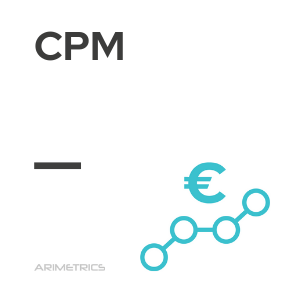
Definition:
CPM is short for Cost per Thousand, in English the “M” is used as the Roman letter indicating the thousands. The cost per thousand is used by internet providers to put a price on advertising banners. Sites that sell online advertising guarantee an advertiser a certain number of impressions (number of times a banner ad is downloaded and, presumably, viewed by visitors. The price is negotiated per thousand ad impressions.
Calculation of the CPM
Calculating the CPM is critical to understanding the cost of advertising campaigns and comparing their effectiveness with other advertising methods. The CPM metric is calculated by dividing the total cost of placing the ad by the number of impressions (in thousands) generated by the ad. The formula is:
CPM = (Total campaign cost / Number of impressions) × 1000
CPM is a useful tool for comparing the relative effectiveness of different advertising media and evaluating the overall costs of advertising campaigns. It is especially valuable when the objective is to achieve high reach and visibility.
How to calculate CPM when visualizations cannot be measured
In situations where views are not easily measurable, CPM offers a way to estimate the cost of advertising based on projected views. In media where it is not possible to count exact views, CPM is based on cost per 1000 estimated ad views.
This traditional way of measuring advertising cost can be supplemented with performance-based models such as percentage of sale or cost per acquisition(CPA). This allows advertisers to evaluate the impact of their campaigns not only in terms of reach, but also in terms of concrete results.
Advantages of the CPM model
The CPM model is popular for several reasons, most notably its ability to reach large audiences efficiently.
- Broad reach: CPM is ideal for campaigns that seek to maximize visibility and brand recognition, as it ensures that the ad is shown to a large number of people.
- Simplicity: The pricing structure is simple and easy to understand, which facilitates campaign planning and budgeting.
- Consistency: Provides a stable basis for measuring the cost of advertising, regardless of fluctuations in ad performance.
Challenges of the CPM model
Despite its benefits, CPM presents certain challenges that advertisers must consider in order to maximize ROI.
- Lack of focus on performance: CPM does not take into account whether ads generate clicks or conversions, which can be a disadvantage if the main objective is user action.
- Actual viewability: It does not guarantee that the ad will actually be seen by users, since an impression only ensures that the ad was served, not necessarily seen.
- Competition: In saturated markets, CPM costs may increase, which may affect the profitability of the campaign.
Main platforms using CPM
Several digital platforms use the CPM model to sell advertising space, taking advantage of their ability to reach large audiences.
- Google Ads: Allows advertisers to display ads on the Google Display Network, reaching millions of users on websites and applications.
- Facebook Ads: Offers CPM options for ads appearing on Facebook and Instagram, leveraging its vast user base to maximize reach.
- Instagram Ads: As part of Facebook, Instagram also uses CPM to deliver engaging visual ads to its global audience.
- Bing Ads: Microsoft Advertising offers CPM campaigns targeted to its Display network.
- LinkedIn Ads: Uses CPM to reach professionals and companies, ideal for B2B marketing campaigns.
- Twitter Ads: Offers CPM options to reach X users with ads in their feed and other locations within the platform.
